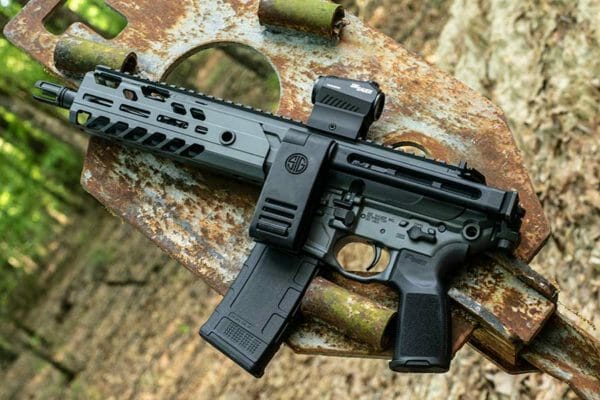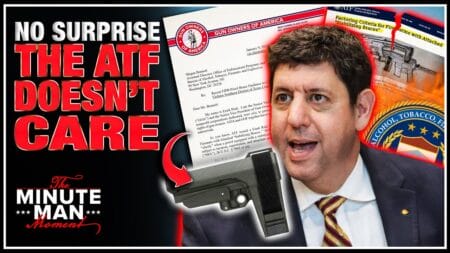
U.S.A. –-(AmmoLand.com)- Two new lawsuits over the Bureau of Alcohol, Tobacco, Firearms and Explosives (ATF) controversial pistol brace rule were filed yesterday, with over half the states and the country joining in suits challenging the ATF’s rule.
Gun Owners of America, Gun Owners Foundation, and the state of Texas teamed up to sue the ATF. over what they see as an unconstitutional rule that violated the American Procedures Act (APA). The lawsuit highlights that both pistols and short-barreled rifles (SBR) are protected arms. It points out that SBRs are also no more dangerous than any other firearm and that the length doesn’t make it any more lethal. It also breaks down the history of the National Firearms Act (NFA) and shows that it was a failed attempt to ban pistols. That SBR regulation of the law was a left-over piece of legislation that was never removed and served no purpose.
The lawsuit also highlights that the new rule violates the Fifth Amendment protections against self-incrimination since the ATF now considers the firearms to be unregistered SBRs, and it requires gun owners to report to the ATF that they own these guns. Also, anyone registering in one of the six states where SBRs are illegal will have their Form 1 rejected. During the registration process, the Chief Law Enforcement Officer (CLEO) will be notified, which could lead to an arrest. It isn’t just the six states where SBRs are illegal; twenty-four states make it illegal to possess an SBR without obtaining a tax stamp first, meaning anyone registering their firearm has incriminated themselves.
The lawsuit takes aim at the ATF’s enforcement discretion. The groups highlight how the enforcement discretion can be reversed. The group points to the ATF telling a GOA lawyer that if the National Instant Criminal Background Check System (NICS) does not return a result within 88 days that the registration will be rejected, and an enforcement action will be taken against the gun owner. The lawsuit also points to the contradictory answer that AmmoLand News received from the ATF when addressing the same subject. The groups point to this as how the ATF can reverse itself as it sees fit. The ATF doesn’t mention using its enforcement discretion on other items, such as non-NFA shotguns such as the Mossberg Tac-14 or Remington Shockwave equipped with pistol braces. On a recent call, the ATF said these firearms could not be registered because they were never meant to be fired with one hand.
The group points out that even if the ATF doesn’t reverse itself on its enforcement discretion doesn’t mean that the Department of Defense (DoD) must exercise the same discretion. Military members who live on base fall under the DoD’s jurisdiction. Many of these troops own pistols equipped with stabilizing devices. Since these are now considered SBRs, these military members can be arrested for having an illegal SBR.
The suit also attacks the rule for failing the Due Process Clause of the Fifth Amendment for its vagueness. It also fails the Rule of Lenity, which “forbids a wholesale administrative reinterpretation of a statute that retroactively criminalizes possession of previously legal firearms.” The Rule of Lenity states that an interpretation of a criminal statute must favor the defendant. This rule was cited throughout the Cargill case that saw the Fifth Circuit Court of Appeals rule that the bump stock ban violated the APA.
The case also says the rule is vastly different from the proposed one. It highlights the removal of Form 4999, the pistol point system. Many of the 210,000 comments addressed concerns about how the calculations were done. Since the rule was vastly different from the draft rule, the plaintiffs feel that the ATF didn’t allow the people to comment on the rule now in effect.
Another APA violation is that the rule went into effect immediately. The APA requires at least 30 days between publishing a rule and the rule going into effect without showing “good cause” as to why the grace period should be removed. The plaintiffs argue that the defendants did not show “good cause” and therefore violated the APA.
The plaintiffs also take a swipe at the NFA itself by calling the $200 tax fee a direct tax on a right. According to the Supreme Court case Murdock v. Pennsylvania, the government cannot put a direct tax on a right. That case involved Pennsylvania demanding a Jehovah’s Witness going door-to-door to get a solicitor’s license. SCOTUS ruled that requiring him to get one would violate his First Amendment rights.
“Millions of Americans are facing a very tight deadline to destroy or register their lawfully owned property under this draconian new rule. We hope the court will hear the pleas of gun owners across the country who will be irrevocably harmed by this rule, and GOA stands ready to fight it at every turn,” said Erich Pratt, GOA’s Senior Vice President.
The second case was filed by The Firearms Regulatory Accountability Coalition, Inc. (FRAC), SB Tactical, B&T USA, and twenty-five state’s attorney generals with the help of the National Rifle Association (NRA). This suit was filed in North Dakota.
The case takes aim at the ATF’s estimates of pistol braces which the agency estimates is three million. The plaintiffs believe this number is incredibly low and point out that the ATF only used estimates for braces sold after 2020. SB Tactical states that since 2020 the company has sold 2.3 million braces. Since braces have been sold since 2014, the number of three million is low. The ATF cost-benefit analysis would be way off if the plaintiffs were correct.
The suit claims that pistols equipped with a stabilizing device do not fall under the Gun Control Act (GCA) or the NFA statutory definitions. The plaintiffs point out that the original laws surrounding short firearms were to prevent the guns from being shortened, making them more concealable and attractive to criminals. By contrast, adding a brace would make the gun less concealable, turning the reason for banning shortened firearms on its head.
The plaintiffs claim the ATF misapprehends the term “designed.” The ATF used evidence such as if a gun is more accurate or more enjoyable to shoot while shouldered with a brace. The plaintiffs believe those characteristics are irrelevant. How a consumer uses an item should not reflect on the reason a manufacturer designed a product.
The plaintiffs claim that braced firearms are in common use. Under the Supreme Court’s Heller decision, the government cannot ban firearms in common use. With millions of braced firearms used by Americans, the ATF cannot ban these guns without violating the principles in Heller.
The plaintiffs also take issue with the ATF’s unwillingness to specify its metrics for deciding if a brace would be allowed. There are no hard numbers for surface area, length of pull, weight, or many other metrics that the ATF considers when determining if a firearm is a pistol with a brace or an SBR. The ATF considers this a “holistic” approach. The plaintiffs consider it unworkable.
“We feel that there is a positive trend towards regulatory accountability in the Courts, and we are confident that the Courts will continue to hold the ATF accountable for their pattern of regulatory overreach and ever-shifting positions,” Travis White, FRAC’s President & CEO, said in an email.
Both groups are asking for the courts to step in and stop the ATF from continuing the implementation of the rule.
About John Crump
John is a NRA instructor and a constitutional activist. John has written about firearms, interviewed people of all walks of life, and on the Constitution. John lives in Northern Virginia with his wife and sons and can be followed on Twitter at @crumpyss, or at www.crumpy.com.









Watch the courts drag this out for 5-10 years. Rights delayed are rights denied, and waiting for courts to declare this totally unconstitutional rule null and void is unacceptable. There must be consequences for the agency for infringing.
Anyone know where suit was filed? I’m guessing since Texas is a plaintiff that it was filed with 5th circuit. If so – good choice. Following on recent favorable rulings, hopefully they will look with clear eyes instead of prior convictions and pre-determined results (unless of course those point toward freedom). Similar suit needs to be filed with St. Benitez so it can get opposite ruling from enbanc panel of 9th circuit. Split courts gets us to SCOTUS for definitive ruling and at least partial end of NFA. Of course some judges in 9th are sane, so possibly they could… Read more »
Gold Star to you Mr. Crump. You are an inspirational tireless advocate.
Having a conservative AG instead of the previous RINO is making all the difference for Idaho.
Our AG Austin Knudsen just filed suit on the clowns at the ATF over thier brace ruling . Austin Knudsen is about to show the corrupt ATF where the big grizzley bear shits in the woods in Montana .
The only “court” that they wiII understand is the court of the field, a la Lexington and Concord.